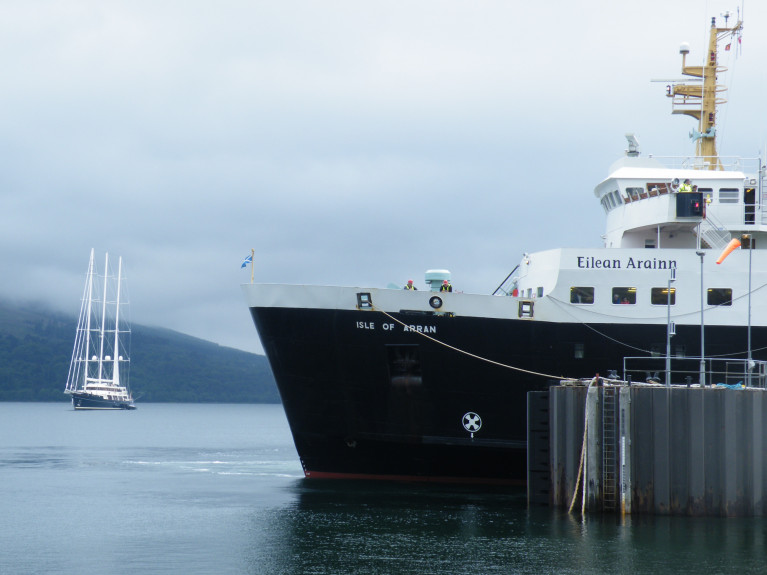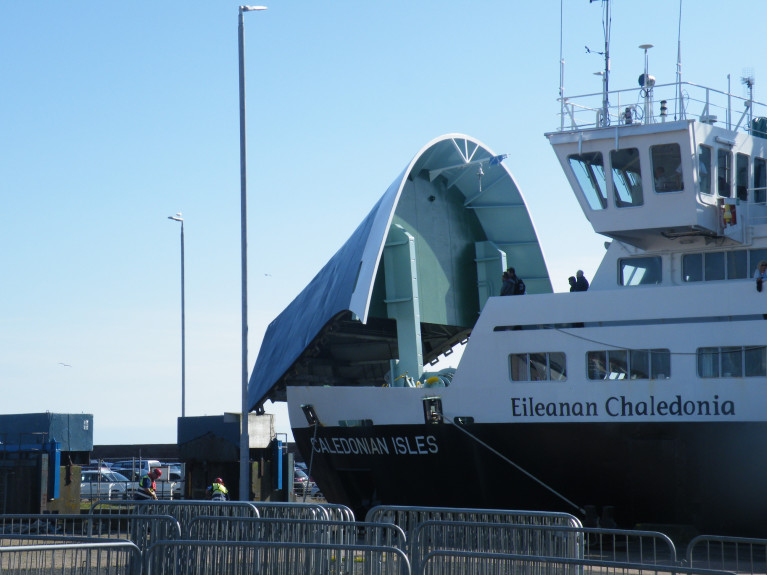Displaying items by tag: Scottish Western Isles
A spare ferry that operates Scotland's most southerly island year round ferry route (peak times) on the Clyde, the MV Isle of Arran, has according to CalMac, since last week temporarily taken over an overnight freight run in the Western Isles.
This is to provide essential freight cover between Ullapool and Stornaway, the capital of Lewis and Harris in the Outer Hebrides.
Isle of Arran is providing two freight sailings while the MV Loch Seaforth is being replaced. Afloat adds the Loch Seaforth is the largest ship in the Scottish state run operator, and which was built by the same shipyard of Irish Ferries cruiseferry W.B. Yeats.
The MV Isle of Lewis was previously carrying out this Western Isles service - however, the ferry is unable to continue to do this as it cannot maintain three return crossings in 24 hours due to crew availability. CalMac cited last Friday, that it will continue to operate the day services.
Specialist engineers are currently working on the Loch Seaforth engines in a yard in Greenock, on the Clyde and with the ferry back in service as soon as possible.
CalMac added this will mean that one ferry will be serving the Ardrossan-Brodick (Isle of Arran) route from this Thursday, 29 April, the MV Caledonian Isles, until a timescale for repairs has been confirmed.
Additional capacity will be provided by doubling up sailings on the Claonaig-Lochranza route during this time.
Passengers who have already booked sailings between Ardrossan and Brodick during this period will be offered alternative sailings as a priority. Space will be limited on 30 April and 1 May.
The 'summer' ferry service to the Mull of Kintyre through Campbeltown (from Ardrossan), which was set to restart on 29 April, has been suspended to accommodate essential demand elsewhere.
These changes were made by using a route prioritisation process which allows CalMac to move ferries around to where demand is most needed when there is extra pressure on the network.
The possibility of hiring a vessel on a temporary basis has been explored but unfortunately, none are available at short notice. This includes the Pentalina which is not going to be free for a number of weeks. Afloat adds this ferry is a former Pentland Ferries that served the Orkney Islands.
Robbie Drummond, Managing Director of CalMac, said: "It is vital that a freight service is provided on the Stornoway-Ullapool route and this movement of vessels is necessary to provide this.
"This situation is far from ideal, and we apologise for how these changes will affect passengers. We will endeavour to offer alternative sailings to everyone who has already booked tickets between Ardrossan and Brodick.
"We know how disruptive this will be for customers and we will keep everyone informed of any further developments. Thank you for your patience at this time."
Largest UK Ferry Operator Offers Bi-Lingual Gaelic & English Customer Care Service
The largest UK ferry and harbour operator is adding to its support for Gaelic speakers by offering a bi-lingual English and Gaelic customer care service.
As a pilot project over the summer the Scottish ferry operator, Caledonian MacBrayne (CalMac) created a new customer care centre in Stornoway, Isle of Lewis (see Afloat coverage of Irish Sea ferry trials). The pilot project has led to six new jobs in the capital of the island which forms part of the Outer Hebrides. CalMac has now confirmed this as a permanent fixture with staff there enhancing the Gaelic face of the company.
Previously assistance from a Gaelic speaker was only available to Gaelic-speaking customers telephoning or visiting port offices in Gaelic-speaking areas, but now anyone who would like to make an enquiry in Gaelic can be transferred to a native speaker to deal with their booking.
The Stornoway team will also be steadily transforming CalMac's social media channels into a bi-lingual offering as well.
There are around 60,000 Gaelic speakers in Scotland, and the majority of people living in the Western Isles are able to speak Gaelic.
'We are committed to looking at ways of spreading jobs more evenly across our area of operations and I'm delighted to confirm that the summer pilot we ran in Stornoway will now be a permanent fixture in the town,' said CalMac's Managing Director, Robbie Drummond.
'Given the prevalence of the Gaelic language in the Western Isles it was a natural step to make this the centre of our new bi-lingual customer service offering.
'This is something we have been keen to introduce for some time and this new centre now gives us the capacity to support this.'
CalMac has long history of support for the Gaelic language, including as the principal commercial supporter of the Royal National Mod.
Shona MacLennan, Chief Executive, Bord na Gaidhlig welcomed the news.
'We always welcome new developments which contribute to the National Gaelic Language Plan's aim that more people use Gaelic more often in more situations. CalMac's introduction of this service will support that aim, and is particularly appropriate in their customer care centre which in Stornoway. By locating those jobs in a Gaelic speaking community this will bring important economic benefits to the Western Isles,' she said.
CalMac currently employs around 1700 people from Campbeltown (Mull of Kintyre) in the south to Stornoway in the north, 60% of them living and working in fragile coastal or island communities. Last year they carried more than 5.6 million passengers on its fleet of 33 vessels across 28 routes to island and remote mainland destinations.
CalMac's customer service team handles more than 300,000 calls and 44,000 emails every year.
They have achieved the highest level of accreditation from the Contact Centre Association for the quality of its customer service who described them as 'a competent, well managed, highly customer focused operation.'
They were particularly impressed by the development and use of social media to keep passengers up-to-date. Over the last year the team managed almost 30,000 social media messages and has attracted more than 100,000 online followers.
'Our social media platforms have a large and loyal following which continues to grow as passenger numbers increase. Being able to offer bi-lingual messages allows us to focus even more closely on how we speak to customers in a way that suits them best,' added Robbie.
Largest Vessel Transits Samuel Beckett Swing-Bridge
She remained alongside this berth which is normally used by large commercial ships until the vessel sought a berth much closer to the city-centre. This led to a shift of berths in the evening when the 2003 built vessel headed upriver to the Dublin City Moorings facility at Custom House Quay, but this firstly required transiting through two bridges.
With a beam of 10.6m Fortunate Sun entered through the East-Link toll-lift bridge followed by the Samuel Beckett bridge, the Liffey's newest crossing point which opened in late 2009. The €60m bridge was commissioned by Dublin City Council and designed by the Spanish architect engineer Santiago Calatrava. To read more on the bridge click HERE.
Fortunate Sun is registered in the Caymen Islands and is capable of over 17 knots on a range of 5000 nautical miles. She has a steel hull and an aluminium superstructure and interiors also by Tim Heywood Design. In the early hours of tomorrow morning the vessel built by Oceanfast is to depart through the 5,700 tonnes bridge which was delivered by barge after a five-day voyage from Rotterdam.
There has been previous transits of the bridge notably the annual Dublin Rally organised by the the Inland Waterways Association of Ireland (IWAI). This year's Dublin Rally took place on 1 May when boats travelling on the Royal Canal descended via Croke Park and entered the Liffey at Spencer Dock. This required the Iarnrod Éireann bridge-lift and the water level in Spencer Dock to be lowered so to allow safe clearance under the Sheriff St. bridge.
From there the IWAI flotilla made the short passage downriver to re-enter another inland waterway system at the Grand Canal Dock, marking where the Liffey connects with the city's southern canal. The 2011 Dublin Rally was the first time since 1955 that boats could enter Dublin from the Shannon via the Royal Canal and the first time since 2004 that boats also joined from the Royal Canal.
- powerboats
- motorboats
- inland waterways
- Dublin Port
- Dublin
- Grand Canal
- IWAI
- Royal Canal
- DDDA
- Inland Waterways Association of Ireland
- Dublin City Council
- Spencer Dock
- River Liffey
- Ports and Shipping News
- EastLink Toll Bridge
- Dublin Port news
- Grand Canal Dock
- Dublin Docklands Development Authority
- M.Y. Fortunate Sun
- Tim Heywood Design
- Lifffey
- Dublin City Moorings
- Custom House Dock
- Powerboat news
- Motoryachts
- Sir John Rogerson Quay
- Inland Waterways news
- Dublin Rally
- Ianrod Eireann
- Oceanfast
- Scottish Western Isles


























































